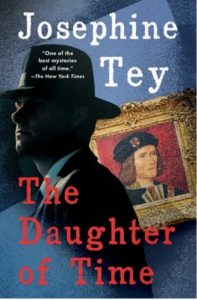The detective novel written by the author Elisabeth MacKintosh, under the pseudonym of Josephine Tey, was a very relevant work in its time, since it investigated the role of Richard III of England in the death of the Princes in the Tower and the Crime Writers Association named it as the best work of all times.
Its author, born in Scotland in 1896, published it in 1951. It was her last book before her death in 1952.
In 1990, it was voted number one in the list of the 100 best detective novels of all time compiled by the British Crime Writers’ Association.
The title of the novel is taken from an old proverb («Truth is the daughter of time») that Tey quotes as the novel’s epigraph. Like all aphorisms, this proverb has been quoted, paraphrased or directly improved upon many times over the centuries by many famous thinkers such as Aulus Gellius and Abraham Lincoln.

Synopsis
Alan Grant, a Scotland Yard inspector is feeling bored while confined to his hospital bed with a broken leg. Marta Hallard, an actress friend of his, suggests that he should amuse himself by investigating a historical mystery. She brings him some photographs of historical figures, aware of Grant’s interest in human faces. He is intrigued by a portrait of King Richard III. He prides himself on being able to read a person’s character from their appearance, and King Richard strikes him as a gentle, kind, wise man. Why is everyone so sure he was a cruel murderer?
With the help of other friends and acquaintances, Grant investigates Richard’s life and the case of the Princes in the Tower, testing his theories with the attending doctors and nurses. Grant spends weeks mulling over historical information and documents with the help of Brent Carradine, a sympathetic young American researcher working at the British Museum. Using his detective’s logic, he comes to the conclusion that the claim that Richard is a murderer is a fabrication of Tudor propaganda, as is the popular image of the king as a monstrous hunchback.
One of the most interesting things about the novel is the way it explores how history is constructed and how events come to be widely accepted as truth despite the lack of evidence and logical plausibility.
The protagonist comes to understand the ways in which great myths or urban legends are constructed and how, in this case, the victorious Tudors ensured that their version of history prevailed.
«La hija del tiempo», Josephine Tey
La novela policíaca escrita por la autora Elisabeth MacKintosh, bajo el seudónimo de Josephine Tey, fue una obra muy relevante en su época, ya que investigaba el papel de Ricardo III de Inglaterra en la muerte de los Príncipes en la Torre y la Crime Writers Association (Asociación Británica de Escritores Policíacos) la nombró como la mejor obra de todos los tiempos.
Su autora, nacida en Escocia en 1896, la publicó en 1951. Fue su último libro antes de morir en 1952.
El título de la novela está tomado de un antiguo proverbio («La verdad es hija del tiempo») que Tey cita como epígrafe de la novela. Como todos los aforismos, este proverbio ha sido citado, parafraseado o directamente mejorado muchas veces a lo largo de los siglos por muchos pensadores famosos, como Aulus Gellius y Abraham Lincoln.

Sinopsis
Con la ayuda de otros amigos y conocidos, Grant investiga la vida de Ricardo y el caso de los Príncipes en la Torre, poniendo a prueba sus teorías con los médicos y enfermeras que lo atendieron. Grant pasa semanas reflexionando sobre información y documentos históricos con la ayuda de Brent Carradine, un joven y simpático investigador americano que trabaja en el Museo Británico. Utilizando su lógica de detective, llega a la conclusión de que la afirmación de que Ricardo es un asesino es una invención de la propaganda de los Tudor, al igual que la imagen popular del rey como un jorobado monstruoso.
El protagonista llega a comprender las formas en que se construyen los grandes mitos o leyendas urbanas y cómo, en este caso, los victoriosos Tudor se aseguraron de que prevaleciera su versión de la historia.

